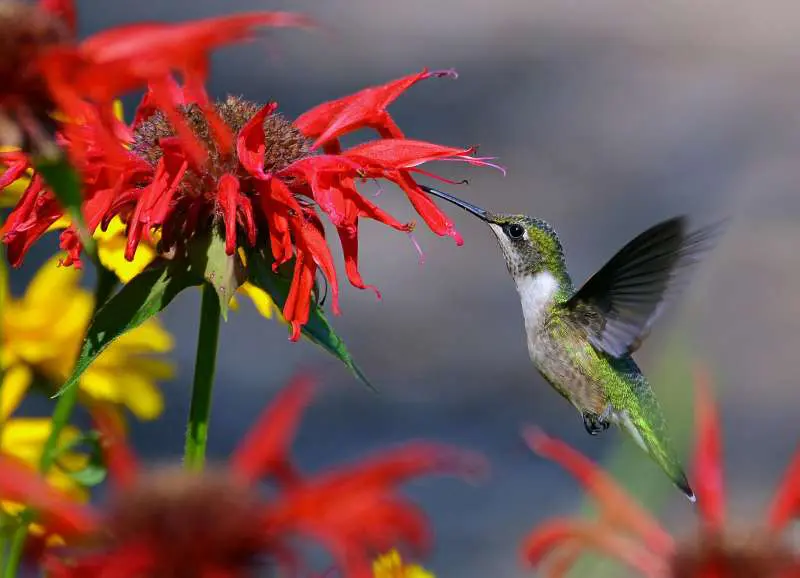If you operated at this bird’s energy level, you would burst into flames!
Throughout North and South America lives one of God’s most amazing creatures, the hummingbird. I like to call it ‘God’s tiny miracle’.
There are more than 300 species of this beautiful minute bird, with its iridescent plumage. Hummingbirds range in size from the tiny bee hummingbird, which is only about the length of an adult’s little finger, to the giant hummingbird, which may reach 22 centimetres (8.5 inches)—the width of a magazine page. There are nine species in North America.
Most North Americans are familiar with either the ruby-throated hummingbird, east of the Rocky Mountains, or the rufous hummingbird, west of the Rockies.
Probably the best-known characteristics of the hummingbird are its extremely rapid wing-beat (50-80 beats per second) and its amazing ability to manoeuvre. It can hover, it can fly backwards and sideways, and it can fly at speeds of more than 90 kilometres an hour (55 miles per hour). In a courtship dive it can reach 100 kilometres an hour (60 miles an hour), swooping down and back again in a U-shaped dive. (This bird’s a real show-off!)
1300 Hamburgers
All this work, of course, uses an enormous amount of energy. An article in The Vancouver Sun (May 3, 1991) noted that, ‘To keep up their blistering lifestyle, hummingbirds, of both sexes, burn up huge amounts of calories—the equivalent [for humans] of 1,300 hamburgers a day, washed down with 60 litres of water, used mainly for cooling purposes.’ Bird expert John Morton, of Wildbirds Unlimited in Vancouver, said in the same article: ‘Were we to operate at their energy level, our hearts would beat 1,260 times a minute, our body temperature would rise to 385 C and we would burst into flames.’ Morton said that, surprisingly, all this activity does not cause the hummingbird to burn out early. ‘They can live up to 12 years, though many live less than six’, he said.
Of course we humans were not designed to operate that way. But the hummingbird shows excellent evidence of careful design for its remarkable lifestyle. Many of these design features are not obvious, however, because of the speed of the wing-beat and the small size of the birds.
Using all that energy, the hummingbird needs an extremely efficient fuel. It obtains this ‘fuel’ in the form of nectar from flowers. It will also feed on a sugar-water mixture if this is placed in a suitable red feeder. You can thereby attract these birds to your garden. In western North America, such feeders promote hummingbird ‘wars’ as the birds defend their feeders against other species of hummingbirds and sometimes against individuals of their own species.
God has equipped the hummingbird with a needle-like bill which penetrates deep into flowers to extract nectar. If the corolla of the flower is too long, the bill can pierce it at the base to gain access. The hummingbird is also equipped with a long, specially designed tongue which is curled up at the edges to form two troughs (which look like a number 3 on its back) to hold the nectar. The long tongue curls up and retracts to the back of the head. The bird takes 13 licks per second. When the tongue retracts into the mouth the nectar is squeezed out into the throat.
Designed for Flight
However, even these features would not give the hummingbird the ability to gather enough food if it were not for the unique design of its wingbeat, which allows the bird to move forward to pierce the flower, hover until it gets enough nectar, and fly backwards to remove its bill from the flower.
When a hummingbird arrives at a flower it stops abruptly and hovers in front of it. It does this first by tilting its body at an angle of about 45 degrees. The wing-beat can now be back and forth instead of up and down. In most birds the up-stroke of the wing is just a recovery stroke to get the wing back into position for the next down-stroke. But the hummingbird has power in both strokes, up and down, and when hovering, back and forth. Its wings can also swivel in all directions from the shoulder. And the wing is straight, without the elbow-like bend in the middle like other birds.
When hovering, each complete beat of the wing describes a figure of eight. As the wings move backward (the up-stroke) they are tilted so that the underside of the wing is facing upward At the end of the stroke they flip over so that the underside of the wing is facing downward to the normal position again. To fly backward the wing is tilted slightly so air is forced forward.
This is not visible to the human eye at normal speed, so most people miss the action because it happens so rapidly that it appears as a blur.
Powerful breast muscles are required for this kind of action, so it is not surprising that the hummingbird’s breast muscles make up one-third of its total body weight.
Rufous hummingbirds migrate great distances, from as far as Alaska to Mexico each year. On the west coast they are able to stop at various places and feed a week or two to build their fuel storage. The ruby-throated hummingbird, on the east side of North America, crosses the Gulf of Mexico. It stores a layer of fat equal to half its body weight before setting off. At the normal rate of use, however, this would not be enough to last the crossing of the Gulf. Yet the hummingbird does complete the journey, so it must have some method of conserving energy on the long flight. Any bird that cannot make this flight non-stop dies in the attempt.
Tired Little Hummingbirds
Hummingbirds are most prevalent in the forests of South America. Here they are very small and extremely active. All this activity causes them to lose a lot of heat across their body surface, which creates another problem: they are not able to supply their bodies with enough energy to remain active for more than 12 hours at a time.
To counteract this, they go into a deep sleep for 12 hours every night. This allows them to control their energy requirements.
During flight, hummingbirds sometimes flap their wings so rapidly that it causes the hum which gave the birds their name.
Remarkable Design
Romans 1:20 tells us: ‘For the invisible things of Him from the creation of the world are clearly seen, being understood by the things that are made, even His eternal power and Godhead; so that they are without excuse’—if they do not believe. Job 12:7 and 9 says: ‘Ask now the beasts, and they shall teach thee; and the fowls of the air, and they shall tell thee … who knoweth not in all these that the hand of the LORD hath wrought this?’
The hummingbird is a very good example of the evidence for God as Creator.
We need to keep in mind that all the hummingbird’s features would have to work perfectly from the beginning for it to have survived—long bill, special tongue, unique rapid wing-beat—in order to be able to gather its highly efficient energy food. The migratory behaviour—energy storage, flight endurance, long distance navigation—must also have been perfect from the beginning so the adults could reach their nesting grounds and return with their young.
I cannot doubt the hand of God the Creator in the design of this remarkable creature. Truly the hummingbird is ‘God’s tiny miracle.’







